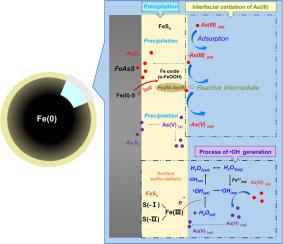解析硫化纳米级零价铁中硫化铁在缺氧水中螯合亚砷酸盐中的作用
IF 12.4
1区 环境科学与生态学
Q1 ENGINEERING, ENVIRONMENTAL
引用次数: 0
摘要
硫化纳米级零价铁(S-nZVI)在水生生态系统中螯合砷(As)的效果显著。然而,硫化后制备的S-nZVI (S-nZVIpost)与砷之间的界面反应机制,特别是硫化铁相(FeS, FeS₂,FeSₓ)在S-nZVI中的功能作用仍未得到充分阐明。研究结果表明,S-nZVIpost中特定的相和元素分布,尤其是硫化铁,对界面催化过程和As固存效率具有关键影响。硫化铁中的硫缺陷位点将吸附的水分子活化成表面结合的羟基自由基(•OHad),从而促进了缺氧条件下As(III)的部分氧化。金属铁芯为As(III)/As(V)渗透到S- nzvipost的内芯区域提供了驱动力,而硫化铁促进了低溶解度As-S沉淀(例如As₂S₃/As₂S₅)的形成和As-S在整个颗粒中的均匀分布。柱突实验证明该方法长期稳定,性能优良。在柱实验中,S-nZVIpost保持几乎完全去除As的时间为14.5小时,而原始nZVI只维持了2.5小时。回收试验进一步验证了其长期运行稳定性。这些发现突出了S-nZVIpost作为一种先进的纳米材料,具有超长的寿命和固定能力,可用于地下水修复和废水处理。本文章由计算机程序翻译,如有差异,请以英文原文为准。

Deciphering the roles of iron sulfides in sulfidated nanoscale zero-valent iron for arsenite sequestration under anoxic water
Sulfidized nanoscale zero-valent iron (S-nZVI) has exhibited remarkable efficacy in the sequestration of arsenic (As) from aquatic ecosystems. However, the interfacial reaction mechanisms between post-sulfidation-prepared S-nZVI (S-nZVIpost) and arsenic, particularly the functional roles of iron sulfide phases (FeS, FeS₂, FeSₓ) within S-nZVI, remain inadequately elucidated. Herein, the specific phases and elemental distribution, especially iron sulfides in S-nZVIpost, were proved to exert a pivotal influence on mediating interfacial catalytic processes and As sequestration efficiency. Sulfur-defect sites in iron sulfides activated adsorbed water molecules into surface-bound hydroxyl radicals (•OHad), thereby facilitating partial oxidation of As(III) under anoxic condition. The metallic iron core provided the driving force for As(III)/As(V) penetration into the inner core region of S-nZVIpost, while iron sulfides promoted the formation of low-solubility As–S precipitates (e.g., As₂S₃/As₂S₅) and homogeneous distribution of As-S throughout the particle. Column breakthrough experiments proved the long-term stability and high performance. S-nZVIpost maintained almost complete removal of As for 14.5 hours in column experiment, whereas pristine nZVI only sustained this performance for 2.5 hours. Recycling tests further validated its long-term operational stability. These findings highlight S-nZVIpost as an advanced nanomaterials with exceptional longevity and As immobilization capacity for groundwater remediation and waste water treatment.
求助全文
通过发布文献求助,成功后即可免费获取论文全文。
去求助
来源期刊

Water Research
环境科学-工程:环境
CiteScore
20.80
自引率
9.40%
发文量
1307
审稿时长
38 days
期刊介绍:
Water Research, along with its open access companion journal Water Research X, serves as a platform for publishing original research papers covering various aspects of the science and technology related to the anthropogenic water cycle, water quality, and its management worldwide. The audience targeted by the journal comprises biologists, chemical engineers, chemists, civil engineers, environmental engineers, limnologists, and microbiologists. The scope of the journal include:
•Treatment processes for water and wastewaters (municipal, agricultural, industrial, and on-site treatment), including resource recovery and residuals management;
•Urban hydrology including sewer systems, stormwater management, and green infrastructure;
•Drinking water treatment and distribution;
•Potable and non-potable water reuse;
•Sanitation, public health, and risk assessment;
•Anaerobic digestion, solid and hazardous waste management, including source characterization and the effects and control of leachates and gaseous emissions;
•Contaminants (chemical, microbial, anthropogenic particles such as nanoparticles or microplastics) and related water quality sensing, monitoring, fate, and assessment;
•Anthropogenic impacts on inland, tidal, coastal and urban waters, focusing on surface and ground waters, and point and non-point sources of pollution;
•Environmental restoration, linked to surface water, groundwater and groundwater remediation;
•Analysis of the interfaces between sediments and water, and between water and atmosphere, focusing specifically on anthropogenic impacts;
•Mathematical modelling, systems analysis, machine learning, and beneficial use of big data related to the anthropogenic water cycle;
•Socio-economic, policy, and regulations studies.
 求助内容:
求助内容: 应助结果提醒方式:
应助结果提醒方式:


